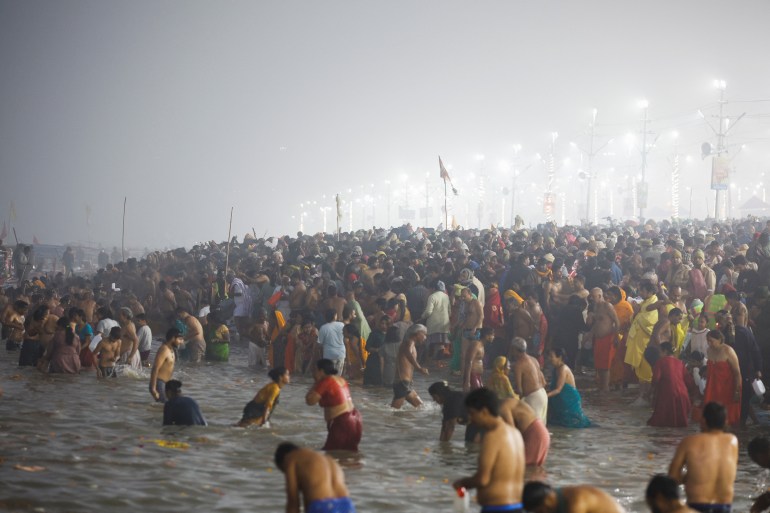Religious event that attracts over 400 million people takes place where the Ganges, Yamuna and mythical Saraswati rivers meet.
Tens of thousands of Hindus seeking absolution of their sins are immersing themselves in freezing waters at the convergence of sacred rivers as India begins the six-week Kumbh Mela festival.
Authorities expect Monday’s first ritual dip in the city of Prayagraj in the northern state of Uttar Pradesh to draw more than 2.5 million visitors.
This will be followed by a “royal bath” on Tuesday reserved for ascetics, in the belief that it absolves them of sin and confers salvation from the cycle of life and death.
“I feel great joy,” Surmila Devi, 45, told the AFP news agency. “For me, it’s like bathing in nectar.”
Also known as the Great Pitcher Festival, the religious event attracts more than 400 million visitors, both Indians and tourists.
The last celebration at the site, the “ardh” or half Kumbh Mela in 2019, attracted 240 million pilgrims, according to the government.
Amid public warnings to walk in lines without halting anywhere, droves of marchers headed for bathing positions to await sunrise at the confluence of the three holy rivers, the Ganges, Yamuna, and the mythical, invisible Saraswati.
Advertisement
Advancing towards the waters’ edge in the winter morning fog, they chanted invocations such as “Har Har Mahadev” and “Jai Ganga Maiyya” in praise of the Hindu deities Lord Shiva and Mother Ganga, who personifies India’s holiest river, the Ganges.
Hindu monks carried huge flags of their respective sects, while tractors turned into chariots for life-size idols of Hindu gods rolled behind them accompanied by elephants.

The Kumbh originates in a Hindu tradition that the god Vishnu, known as the Preserver, wrested away from demons a golden pitcher that held the nectar of immortality.
In a 12-day celestial fight for its possession, four drops of the nectar fell to earth, in the cities of Prayagraj, Haridwar, Ujjain and Nashik, where the festival is held every three years in rotation.
The Kumbh held once in 12 years in this cycle has the prefix “maha” (great) as its timing renders it more auspicious and it attracts the largest crowds.
‘Top notch’ security
Authorities have set up 150,000 tents to accommodate pilgrims, expected to number about three times the population of Russia.
Indian police said they were “conducting relentless day-and-night patrols to ensure top-notch security” for the event.
Some 68,000 LED light poles have been erected for a gathering so large that its bright lights can be seen from space.
Temperatures hovered about 15 degrees Celsius (59 Fahrenheit) overnight, but pilgrims said their faith meant their baths were not chilly.
“Once you are in the water, you don’t even feel cold,” 56-year-old devotee Chandrakant Nagve Patel told AFP. “I felt like I was one with God.”
Advertisement











More Stories
Why fire hydrants and water supply failed during Los Angeles wildfires
Coaching ‘pods’ get mixed reaction from top players at Australian Open 2025
Nigerian air raid targeting bandits mistakenly kills civilians